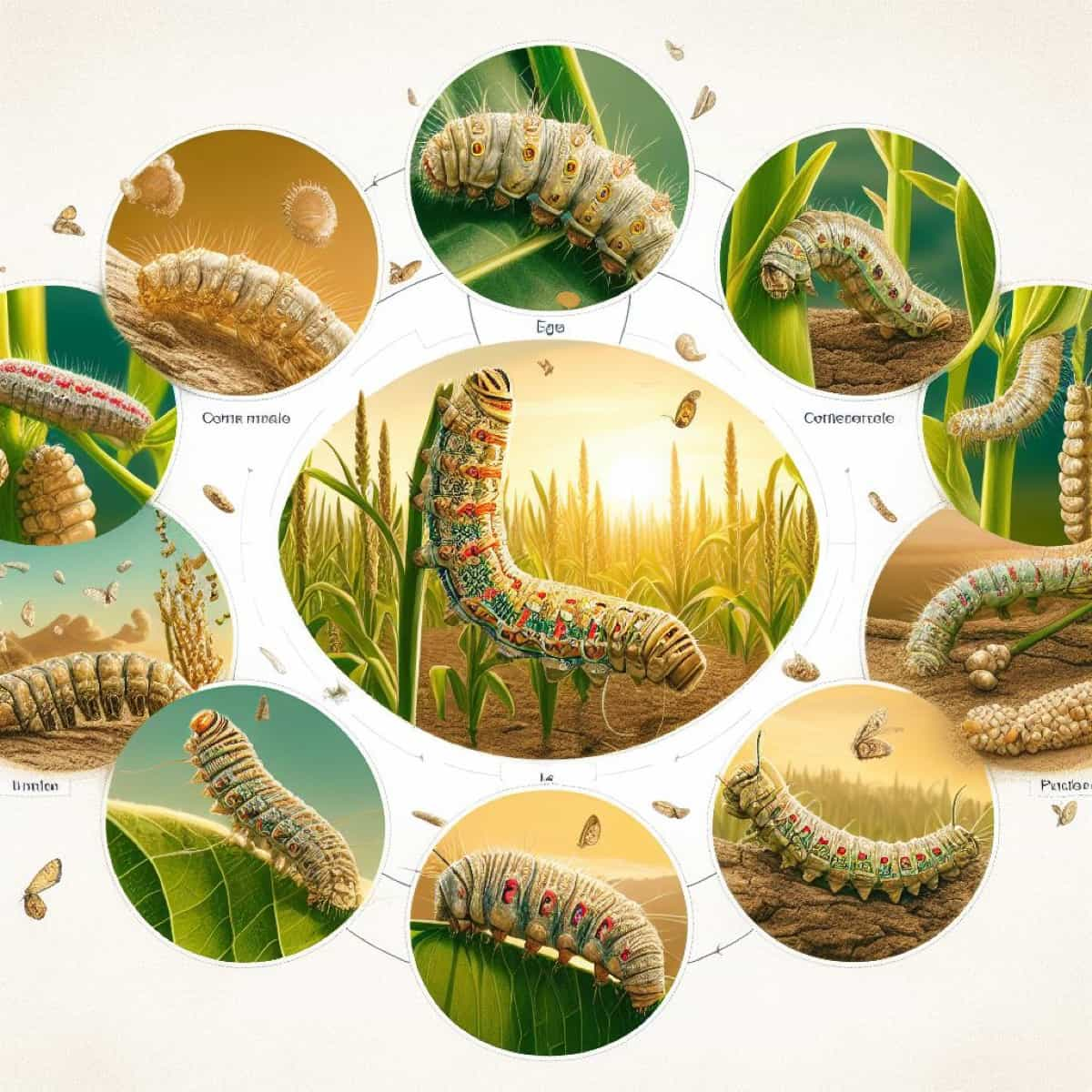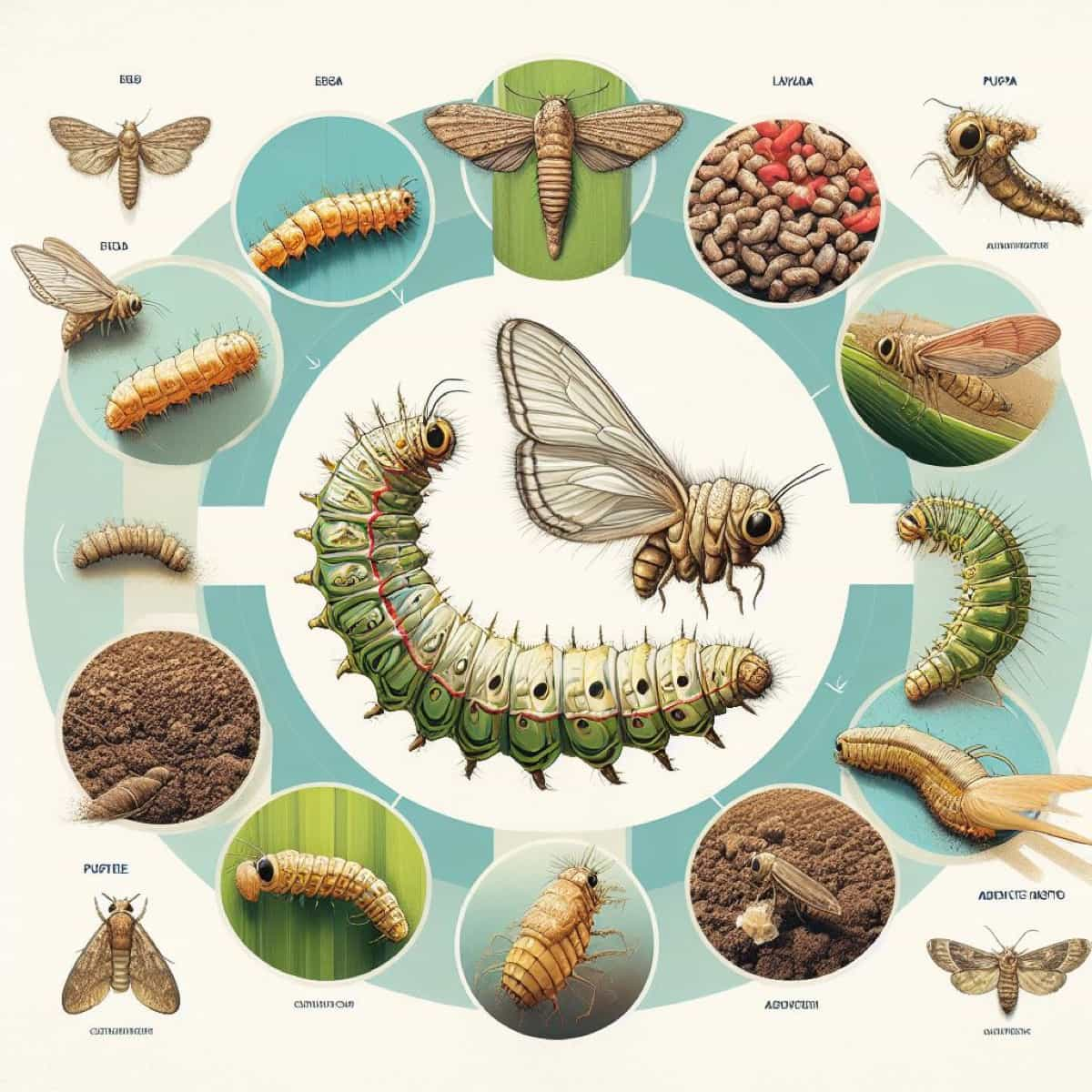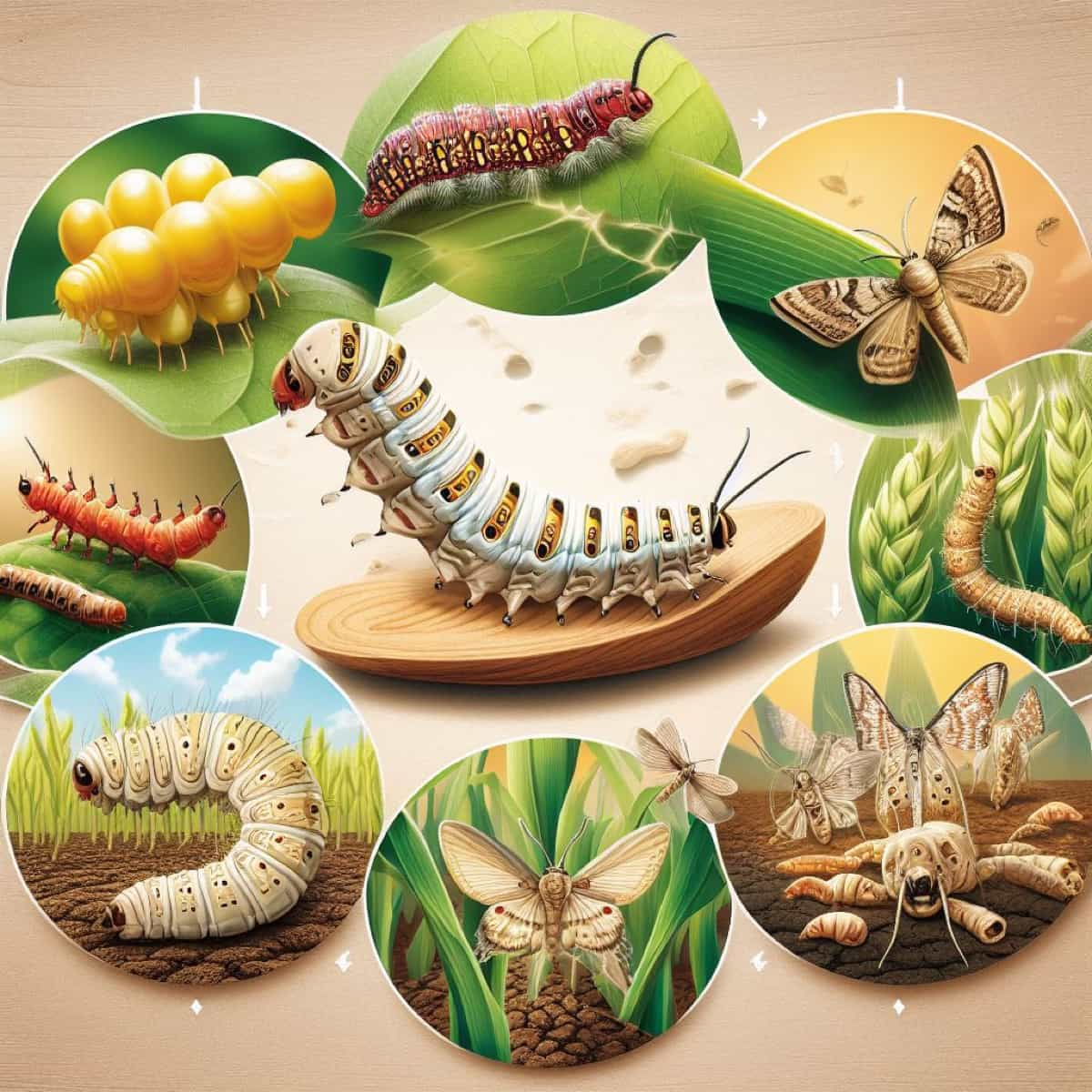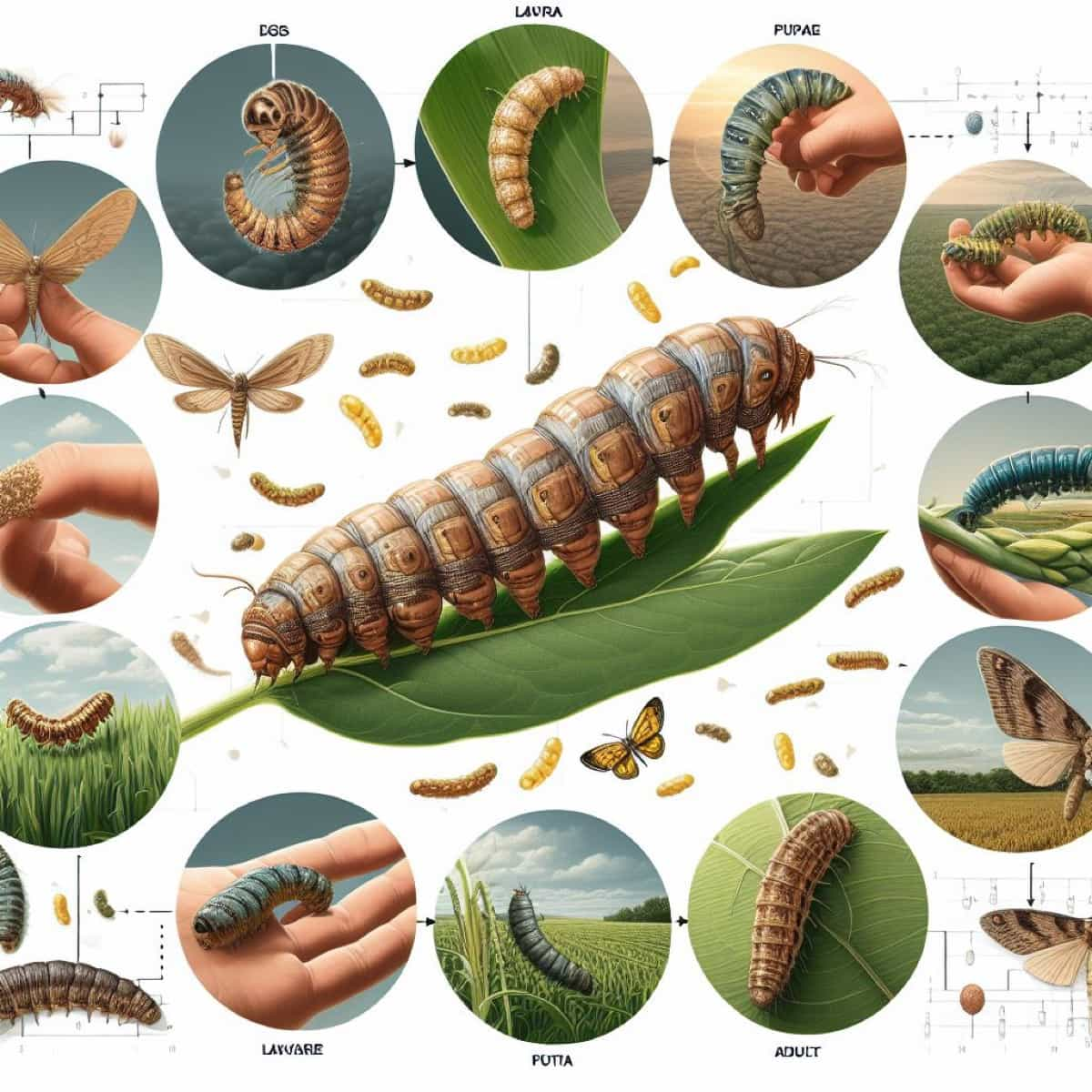Fall Armyworms pose a significant threat to agriculture, necessitating effective pest management. Integrated Pest Management (IPM) offers a holistic approach, combining biological, cultural, and chemical strategies. This comprehensive strategy minimizes environmental impact while ensuring sustainable control of Fall Armyworm infestations.

Integrated Pest Management for Fall Armyworms
Understanding the Life Cycle of Fall Armyworms
Fall armyworms are moths belonging to the Noctuidae family, with four life stages: egg, larva, pupa, and adult. Adults lay the eggs on the underside of leaves, hatching in 2 to 4 days. Larvae feed on crops for 14 to 30 days, passing through six instars. They are green, brown, or black, with a dark head and four black spots on each segment.
They can move long distances for food, forming large groups or “armies” that can devour entire fields. Pupae are formed in soil or under plant debris, remaining for 8 to 20 days before emerging as adults. Adult moths are gray or brown, have a 3 to 4-cm wingspan, have white spots on each forewing and hindwing, and can fly long distances to mate and lay eggs. The life cycle can take 30 to 90 days, depending on temperature and food availability.
Identifying Fall Armyworm Damage in Crops
Fall armyworms are caterpillars that feed on the leaves, stems, and ears of crops. Their dark head capsule with four light-colored stripes and a dark spot on each side helps to distinguish them from other caterpillars. They also have four dark spots arranged in a square on the last segment of their body. Ragged holes in the leaves, frass (excrement) on the plants, and damaged ears with entry holes and silk are signs of fall armyworm damage. Fall armyworms can also cause lodging (bending or breaking) of the stems due to their feeding.
Biological Control Methods for Fall Armyworms
- Predators: These are insects or animals that feed on fall armyworms or their eggs. Some common predators are ladybugs, lacewings, spiders, ants, birds, and bats.
- Parasitoids: These are insects that lay their eggs inside or on the body of fall armyworms or their eggs. The larvae of the parasitoid then feed on the host and kill it. Some common parasitoids are wasps, flies, and beetles.
- Pathogens: These are microorganisms such as bacteria, fungi, viruses, or nematodes that infect and kill fall armyworms or their eggs. Bacillus thuringiensis (Bt), Beauveria bassiana, Metarhizium anisopliae, nucleopolyhedrovirus (NPV), and Steinernema carpocapsae are some common pathogens.
In case you missed it: Biological Control Methods for Fall Armyworms: Best Practices for Fall Armyworm Prevention

Conserving natural enemies in the field, releasing additional natural enemies when necessary, and avoiding broad-spectrum insecticides that can harm them can all improve biological control methods.
Cultural Practices to Manage Fall Armyworm Infestations
- Crop rotation: it is the practice of planting different crops in the same field in different seasons or years. Crop rotation can reduce the buildup of fall armyworm populations and their host plants.
- Trap cropping: This is the practice of planting a crop that attracts fall armyworms more than the main crop around the field’s perimeter. Trap cropping can divert fall armyworms from the main crop and expose them to natural enemies or insecticides.
- Sanitation: This is removing crop residues and weeds that can harbor fall armyworms or their eggs. Sanitation can reduce the sources of infestation and prevent overwintering of fall armyworms.
- Planting date: This is the practice of planting the crop early or late in the season to avoid peak periods of fall armyworm activity. Planting date can reduce the exposure of the crop to fall armyworm damage.
- Resistant varieties: These crop varieties have traits that make them less susceptible or attractive to fall armyworms. Resistant varieties can reduce the damage caused by fall armyworms and lower the need for insecticides.
Physical Control Measures for Fall Armyworms
- Hand-picking: This is the practice of manually removing fall armyworms or their eggs from the plants. Hand-picking can be adequate for small infestations or in home gardens.
- Barriers: These materials prevent fall armyworms from reaching or damaging the crop. Common barriers include row covers, netting, collars, and sticky traps.
- Tillage: This is the practice of plowing or cultivating the soil to expose or bury fall armyworms or their eggs. Tillage can reduce the survival of fall armyworms and disrupt their life cycle.
Chemical Control Options in Integrated Pest Management
- Selection: The insecticide should be effective against fall armyworms, compatible with natural enemies and other IPM methods, and safe for the crop, the environment, and human health.
- Timing: The insecticide should be applied at the right stage of the pest and the harvest, preferably when fall armyworms are young and before they cause significant damage.
- Application: The insecticide should be applied according to the label instructions, using the appropriate equipment, dosage, and frequency.
- Resistance: Rotating the pesticide with other action methods will stop or slow the fall armyworms’ ability to build resistance.
In case you missed it: Cultural Control Methods for Fall Armyworms: Best Practices for Fall Armyworm Prevention

Monitoring and Early Detection of Fall Armyworm Infestations
- Scouting: This is visually inspecting the plants for fall armyworms or their eggs, damage, or frass. Scouting can be done by walking through the field or using a sweep net or a beat sheet.
- Trapping: This is using devices that capture or attract fall armyworms or their adults. Some common traps are pheromone traps, light traps, and pitfall traps.
- Thresholds: These are levels of pest infestation or damage that indicate the need for action. Thresholds can be based on the number of fall armyworms or their eggs per plant, per row, per unit area, or the percentage of plants or ears damaged.
Implementing Sustainable IPM Strategies for Fall Armyworms
- Biological Control Methods: Encourage natural predators like parasitoid wasps and predators, creating a balanced ecosystem. Release beneficial nematodes to target Fall Armyworm larvae.
- Cultural Practices: Rotate crops to disrupt the pest’s life cycle. Practice intercropping with repellent plants like marigolds.
- Chemical Control with Caution: Use biopesticides and insect growth regulators. Minimize synthetic pesticide use to preserve beneficial insects.
- Early Detection and Monitoring: Implement pheromone traps for early detection. Regularly scout fields for signs of infestation.
Economic Impact of Fall Armyworm Infestations and IPM Solutions
- Yield losses: Fall armyworms can reduce crop yield by feeding on leaves, stems, and ears, affecting photosynthesis, transpiration, nutrient uptake, and grain filling.
- Quality losses: Fall armyworms can reduce crop quality by damaging ears, causing mold growth, mycotoxin contamination, insect fragments, and reduced germination.
- Control costs: Fall armyworms can increase crop production costs by requiring additional inputs such as labor, insecticides, equipment, and fuel.
- Market losses: Fall armyworms can reduce crop marketability by affecting consumer preferences, export standards, price premiums, and trade regulations.
Integrating Technology in Fall Armyworm IPM Programs
Agricultural sustainability is improved by incorporating technology into Fall Armyworm Integrated Pest Management (IPM) operations. Farmers receive timely alerts from satellite images, which helps with early detection. Sensor-equipped drones keep an eye on crop health, identifying pests to make targeted interventions. Farmers may access real-time data through mobile apps, providing tailored insights and suggestions. Pheromone-based automated traps effectively entice and catch bugs.
Models of weather prediction aid in predicting favorable circumstances for outbreaks of Fall Armyworms. Digital platforms encourage farmers to share their knowledge and work together cooperatively. Data analytics optimizes resource allocation by streamlining decision-making. These technology advancements strengthen integrated pest management (IPM) tactics, lowering the need for chemical treatments and encouraging environmentally acceptable measures for robust crop protection.
In case you missed it: Wheat Armyworm Management in Wheat: Symptoms, Treatment, Chemical, Biological, Natural, and Organic Control

Frequently Asked Questions (FAQ) on Integrated Pest Management for Fall Armyworms
How Can Farmers Enhance Soil Health to Discourage Fall Armyworm Infestations?
Improving soil health through organic matter incorporation, cover cropping, and reduced tillage can create an environment less favorable to Fall Armyworms. Healthy soils contribute to robust and resilient crops.
What Preventive Measures Can Be Taken Before Planting to Reduce Fall Armyworm Risks?
Employing practices like early planting to avoid peak Fall Armyworm activity, choosing crop varieties with natural resistance, and ensuring field cleanliness by removing crop residues can help prevent initial infestations.
Conclusion
Integrated Pest Management (IPM) is crucial for combating Fall Armyworms. Implementing a combination of cultural, biological, and chemical control methods optimizes effectiveness. Crop rotation, natural enemies, and judicious pesticide use collectively form a sustainable approach, reducing reliance on any tactic. This integrated strategy ensures resilient pest management.
- Beneficial Insects in Pest Management
- Natural Solutions for Pest Control in Flower Gardens
- Types of Fungicides Used in Agriculture
- Common Issues in the Fruit Development Stage of Pomegranate Farming
- Fruit Development Issues in Papaya: Easy Solutions and Treatment
- Soil-Borne Diseases and How to Protect Your Plants
- Practices to Prevent Disease Spread in the Garden
- From Wilted to Thriving: How to Treat Root Rot Naturally in Houseplants
- Natural Remedies to Cure Brown Spots on Fig Tree Leaves